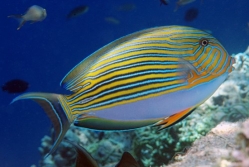 The Clown Tang (Acanthurus lineatus) is one of the most striking members of the Tangs / Surgeons family (Acanthuridae), being one of the most aggressive and can be challenging to keep and care for. It is also known in the trade as the Lined Surgeon and Pyjama Tang.
The Clown Tang (Acanthurus lineatus) is one of the most striking members of the Tangs / Surgeons family (Acanthuridae), being one of the most aggressive and can be challenging to keep and care for. It is also known in the trade as the Lined Surgeon and Pyjama Tang.
Sooner or later as a reef tank hobbyist you're going to want one of these beauties. They are reef safe and live harmoniously with corals and invertebrates.
Being an aggressive species it may be less tolerant of fish tank mates - especially new additions - so get this fish as one of the last fish to be introduced to your system. It is recommended to keep this species as the only Tang in the aquarium. A suitable size aquarium of 250 gallons / 950 liters or larger will be required with plenty of rock work for places to hide as well as large open areas for swimming and cruising it's home, as it is an extremely active species. I have seen the Clown Tang kept with other species of Surgeonfishes, however this Tang reaches a whopping 1' 3" / 38cm in length and only becomes more aggressive with increased size and age making it very capable of damaging (with it's sharp scalpel) other competing species within the reef tank. So if you must add another Tang try and choose one that is physically different in shape and coloration. Plus the bigger the aquarium the better.
Like many Tangs, the Clown Tang will pick and eat algae off the rocks within the aquarium. Additionally it should be offered marine algae / seaweed such as Nori which comes in a variety of types, red, green and brown. Feeding the fish the correct diet will maintain the overall health of the fish. It will also eat many different types of frozen foods available at your local fish store. Good quality flake and pellet foods will also be accepted.
The key to keeping this fish healthy is excellent water quality, with plenty of water flow and oxygenation hence this fish should only be attempted by experienced hobbyists. This means low nutrient levels of nitrate and phosphate and definitely no trace of ammonia or nitrite - so a well established tank is a must! There are a couple of ways to maintaining low levels of nitrate and phosphate by either using GFO products, which can be pricy or use a much cheaper method - Vodka Dosing! Bacteria use Vodka as a carbon source to breakdown nitrates and phosphates aerobically. An efficient protein skimmer is required to complete the process. This method is safe in reef tanks for soft corals as well as LPS, but not safe for SPS if the alkalinity is too high. Before implementing this method it is required that further research is done.
To complement high water quality parameters it is recommended that pH and salinity should also be stable. pH can be maintained with good alkalinity and salinity can be controlled by using an auto top off / auto top up unit that replaces water as it evaporates - an essential peace of kit for any reef aquarium.

